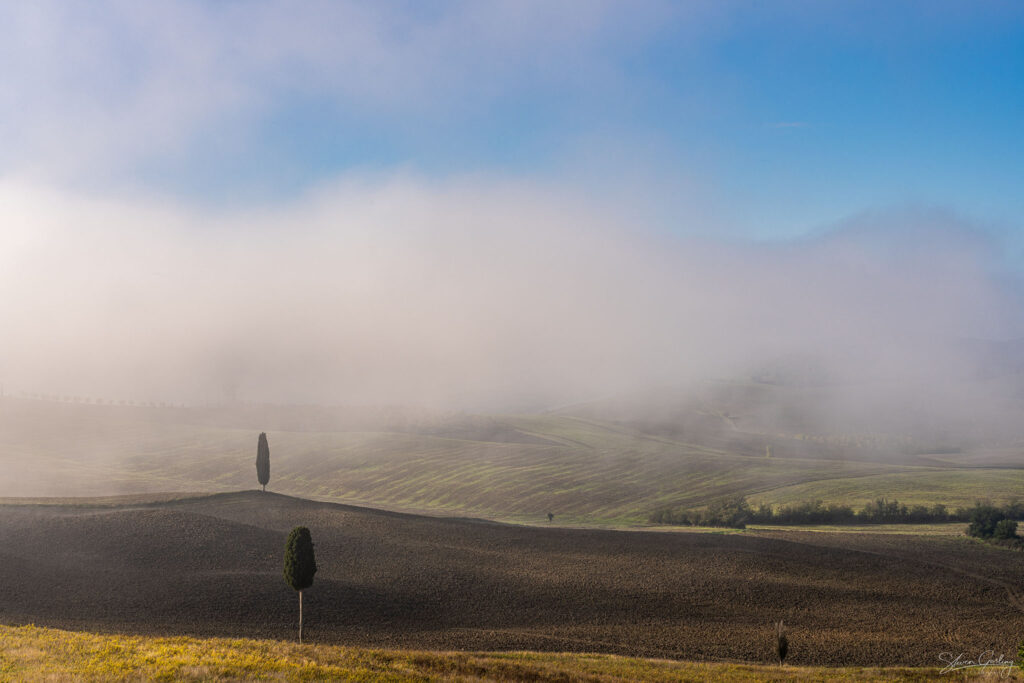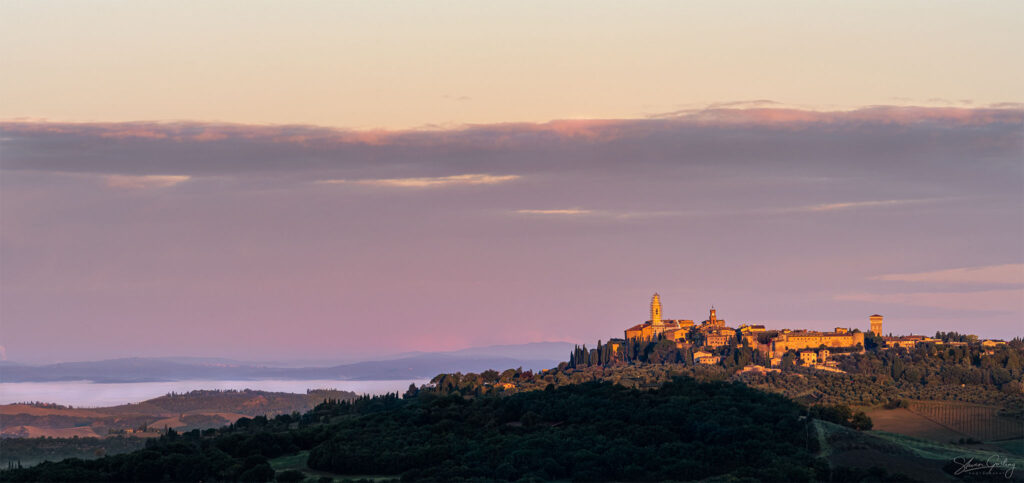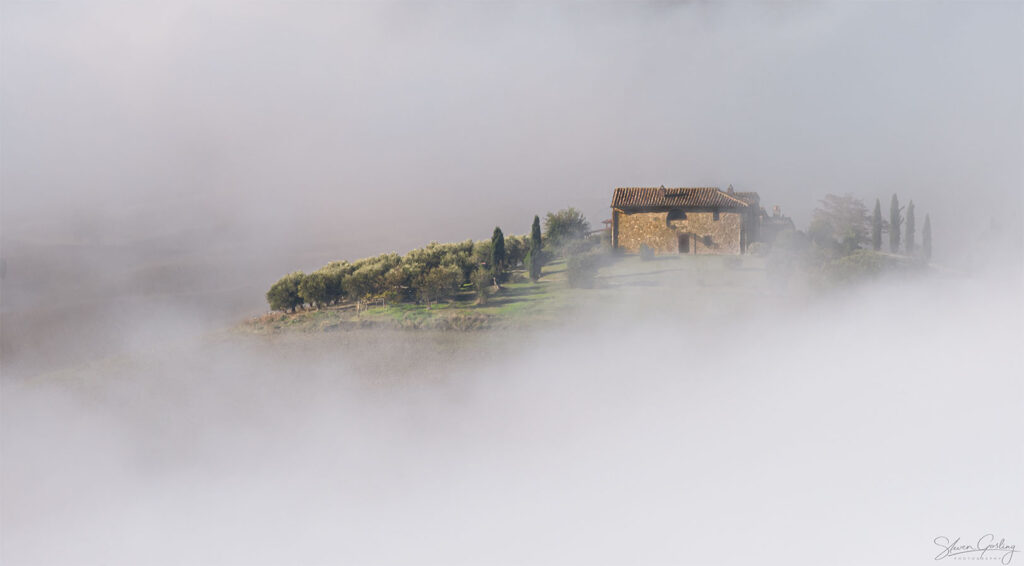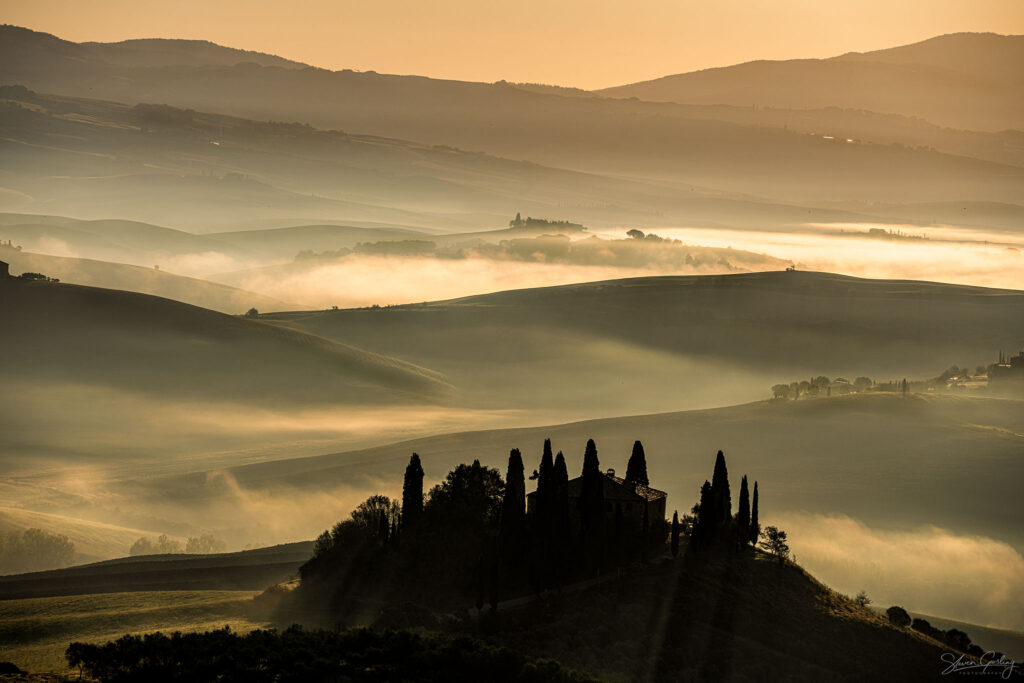All images shown on this article are from my Tuscany Autumn Photographic Tour
As most landscape photographers will know, the higher you go the colder it generally gets – roughly 2° decrease for every 1000ft (304m) of ascent.
A temperature inversion is the reverse of what you’d normally expect – it get’s warmer as you head higher. It’s basically a layer of warm air in our atmosphere and it’s depth can vary in relation to whichever weather system is currently in place and of course the terrain and whether you are inland or near the coast.
Needless to say mountains (or hills) affect how the elements behave. In the UK it’s often just colder, wetter and windier up on the summits.
To catch sight of differing types of temperature inversions, you need to consider some important points.
First of all, on clear windless nights valley bottoms cool by radiation – the heat is rising by conduction. A bit like steam from a kettle. The heat from the valley bottom spreads ever upwards but only through a shallow layer. As a consequence of this, the air itself close to the ground also cools.
It’s worth noting that cool air is denser than warm air and so when you have conditions like above you’ll find it very cold at ground level but warmer up on the summits.
At dawn, the sun begins to heat the ground and over just a couple of hours or so all the moisture is released up into the atmosphere.
This means you see the valleys with mist or cloud in the bottom.
But beware because as the sun climbs higher over the horizon these silky white clouds soon dissipate leaving behind less than ideal visibility and hazy conditions (though this tends to improve come the afternoon). So head up to higher ground before dawn. This all happens throughout the year but more so in the autumn or winter.

Signs to look for
After sundown pay attention to any smoke from chimneys rising and flattening out at a given altitude or a subtle haze forming in the valleys below – these will be clues as to a temperature inversion forming for the following morning.
So, when looking at the weather forecast, I will look to see if the wind speeds are relatively calm, will there be a clear night and how deep and sheltered are the valleys near my location.
In effect, the weather man on the TV will explain there’s a high pressure system lounging about a given area, winds will be light and it may get cold overnight. Consequently you can be pretty certain you’ll see the sights described above.
Always, endeavour to go where the weather tells you to go – and not plan to spend the night somewhere and hope you’ll catch a temperature inversion. Note the terrain, too. A prominent peak looming over sheltered valleys would be a safe bet or a high summit looking out over a plateau.
Valleys with large bodies of water, such as those found in the Lake District for example are ripe for such scenes too – namely due to cooling water and so on.
High pressure systems generally mean calm and settled conditions and often clear skies or at the very least not much cloud at all. It’s this you need to look for on weather charts/forecasts you see.
However, just because there maybe a predominant high pressure system in place doesn’t mean you won’t get any cloud.

Cloud Inversions
Which leads us to the best type of temperature inversion of them all – what most photographers call ‘cloud inversions’.
In effect, any thick layer of cloud you’d expect to see up in the sky is now hugging the valley bottoms – and only the highest peaks are poking out under clear blue skies.

How does this happen?
Basically in exactly the same way as described above but with a sheet of cloud. The cool condensed air of these usually fluffy clouds gets trapped below a warm layer of atmosphere. It will usually be very cold and damp in the valleys, with hardly a breeze but no precipitation.
Think of those mornings you experience with thick, cold, moist fog in the winter – there’s a good chance you’re in a cloud inversion. Head upwards a thousand feet or so and you could be in warm air under clear blue skies!
Statistically, it’s autumn and winter in the UK that you are more likely to chance upon these cloud inversions.
Why? Well, to see such sights on our modest high ground you need a number of favourable conditions to occur. North easterly cold fronts along with a high pressure system make for guaranteed cloud inversion conditions in the main.
If the winds are westerly it can be somewhat of a contrast though. In the Peak District you’d think Kinder Scout would be good because of it’s altitude – but it’s a big mass. So, on it’s western side the pressure it would force into any incoming winds would be considerable – and in turn you’d likely get the cloud creep it’s way over the plateau and not see much at all.
In north easterlies, this wouldn’t be so much of a problem due to the prevalent terrain locally. So, there’s lots to consider.

How to shoot Cloud Inversion Layers?
Simple. Get above them! But ideally you need low early morning golden light. This type of light offers better texture to the cloud tops. Get into position before sunrise so you can start to see the orange glow of the sun. Look for where the sun will rise and where the suns rays will hit the tops of the clouds (which may be moving) and where it will hit the peaks.
I tend to use a tripod, set a ow ISO such as 50 or 100, f11 to f16 range, and what ever shutter speed is needed (usually a couple of seconds).
As the sun gets brighter you may need a graduated filter to keep the tones in the sky saturated.
Then the suns too high in the sky and the clouds and mist start to dissipate and its all over! But there’s always tomorrow, so start watching the weather again.
Credit to Terry Abraham as I borrowed some of this article from him!
